Editor’s note: This story was originally published in 2019, in issue 1 of Magneto magazine, a rather lovely thing that you may enjoy having on your coffee table and, who knows, even reading! It was the for the first-ever back-to-back test of McLaren’s P1 and Senna, conducted on the roads of Scotland. Oh how we all wish we could have been there, right? James Mills.
‘Super’ was no longer sufficient. Porsche, Ferrari and McLaren had embraced hybrid technology, and were competing head-to-head to win the hearts and minds of the next generation of car enthusiasts – not to mention the hard cash of those who wanted the ultimate symbol of performance, engineering and tech ingenuity. The 918 Spyder, LaFerrari and P1 all arrived within a few months of each other in 2013, and the world, it seemed, would never be quite the same again. Forget supercars. What you wanted, what you needed, was a hypercar.
The new breed, while similar in outright potential, drew deep from wildly different gene pools to create distinct experiences. Porsche focused its efforts on creating the complete driving machine, Ferrari amplified the drama by using electric power to simply augment its already-crazy V12, and McLaren went for pared-back precision, an extreme chassis complete with belly-scraping Race mode, unprecedented levels of aerodynamic downforce and even Formula 1-style DRS capability. The P1 was the lightest, the purest – and it seemed to be formed from shape-shifting liquid carbonfibre. Organic, alien, almost alive. Nothing was more ‘hyper’ than the McLaren P1.

But time moves so quickly. Quicker than ever, in fact. Long gone are the days when a new model would come along, redefine our perceptions of what a road car could be and then sit atop the world for year after year until the next epoch-defining wedge of carbonfibre and aluminium was revealed. Just six years after the frenzy of excitement, the adoption of new technology to further the art of the performance car… just six years after the step beyond ‘super’, the hypercar has been caught and overtaken. McLaren’s own ‘regular’ supercar, the 720S, would probably match or beat the P1 around a circuit. Porsche’s ultimate 911 now comfortably eats the 918 Spyder at the Nürburgring. Next week, something else will come along and go quicker still. The supercar landscape is seismic, and you have to move fast not to slip between the cracks.
Today we can forget about the superpower supercar struggle, though. No Porsches, Ferraris or Bugattis. Instead, we’ll revisit the P1 and get a chance to compare it with McLaren’s latest track-focused monster; the Senna. Lighter still, pushed invisibly to the surface with even more determination by the hand of downforce, and so uncompromising it makes the P1 look like a long-legged GT. The Senna will demonstrate how far McLaren has come, determine whether the original hypercar’s iconic status is already null and void, and perhaps allow us to discover whether this frenzied evolutionary pace has rather forgotten the driver in its quest for more speed, faster lap times and ever greater grip. Scotland is our stage and Knockhill is waiting. But first we head to the Cairngorms and the Old Military Road. These hypercars have numberplates, after all.
Road tripping
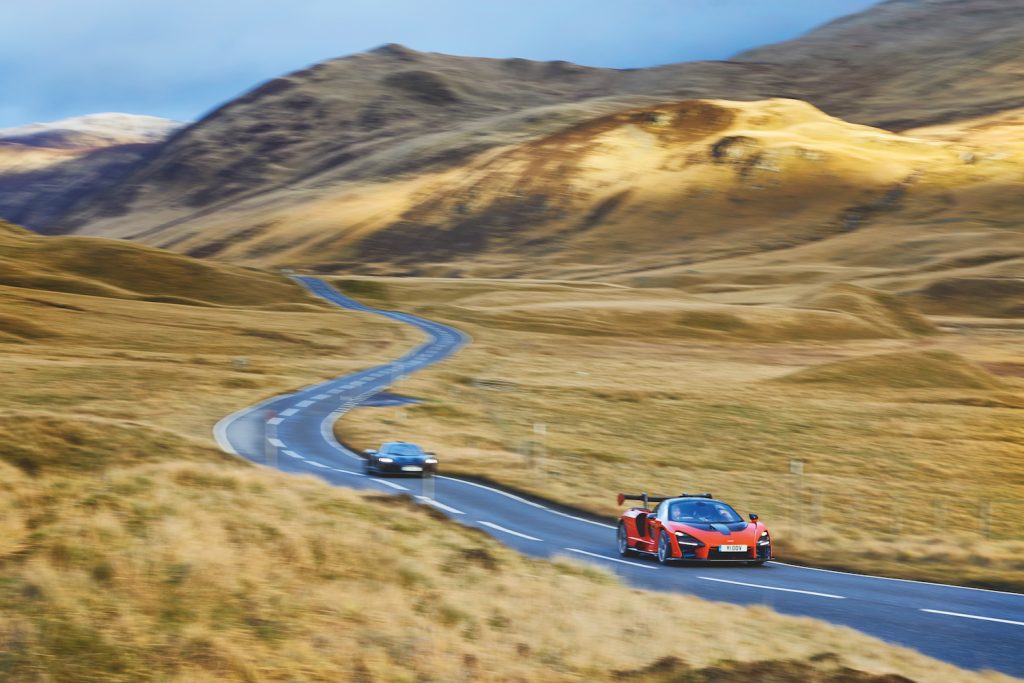
Let’s start with a reminder of the numbers and intricacies of each, because they warrant some scrutiny. The P1’s basic structure utilises a similar carbonfibre tub to the concurrent 650S. However, the MonoCell – McLaren’s carbon tub structure about which its cars were built – was evolved into the even stiffer MonoCage with the addition of an integrated roof structure and intake snorkel for the mid-mounted powertrain. The MonoCage weighs just 90kg, while the P1 also features a heavily reworked version of the 650S’s 3.8-litre V8 twin-turbo, working in combination with an electric motor fitted to the side of the block and connected via an intermediary clutch and gear. The engine contributes 727bhp and 531lb ft to a total combined output of 903bhp and 664lb ft. Short distances (6.8 miles) can be driven on e-power alone and, perhaps more importantly, the motor’s ‘torque fill’ function is said to eliminate turbo lag. It’s fitted with a seven-speed dual-clutch gearbox.
The chassis and aero are equally outrageous. Suspension is by double wishbones all round plus the clever hydraulic RaceActive Chassis Control system, which does away with conventional dampers and anti-roll bars and allows variable ride-height settings. In the track-only Race mode, the car drops 50mm and the spring rate effectively increases by 300 per cent. The rear wing extends 300mm from the body and adjusts its angle for maximum downforce, too. At 161mph in Race mode the P1 produces 600kg of aerodynamic load, and from there starts to trim its wings to ‘spill’ downforce away so as not to overload the suspension. Top speed is 217mph, while the P1 cracks 0-62mph in 2.8 seconds and 0-124mph in 6.8 seconds along the way. Just 300 were built, at a price of £875,000 each.
Head still spinning? Well, that was hypercar circa 2013. The Senna, released in late 2018, has simplified in some senses and become even crazier in others. The hybrid system is gone, hence overall power is down to 789bhp and 590lb ft, and the spectre of turbo lag looms once again. However, the engine is now 3994cc, which should help mitigate against it. The MonoCage has evolved into the MonoCage III (the missing link forms the structure of the 720S) with slimmer pillars yet even more inherent stiffness, and mass has been chased out wherever possible. The gorgeously sculptural seat shells, for example, weigh just 3.35kg each.
In fact, rather than listing ever more exotic materials and unbelievable numbers, just think of the Senna as the P1’s laser-focused core honed and concentrated yet further. It’s nearly 200kg lighter, has a higher power-to-weight ratio, produces 800kg of downforce at 155mph and is even more unapologetic in its track focus. It might not be beautiful, but would you dare look it in the eye and say so? Nor me. McLaren will build 500 Sennas, and each costs from £750,000.
Once owners have taken delivery, I doubt many will trundle up the M8 on a freezing winter’s day sucking in salt and grime under that vast front splitter and then blasting it out in a grubby rooster tail behind. But as I said, you can call them ‘super’ or ‘hyper’ or anything else, but they’re still cars and best enjoyed when moving. Preferably towards the Scottish Highlands.
McLaren P1
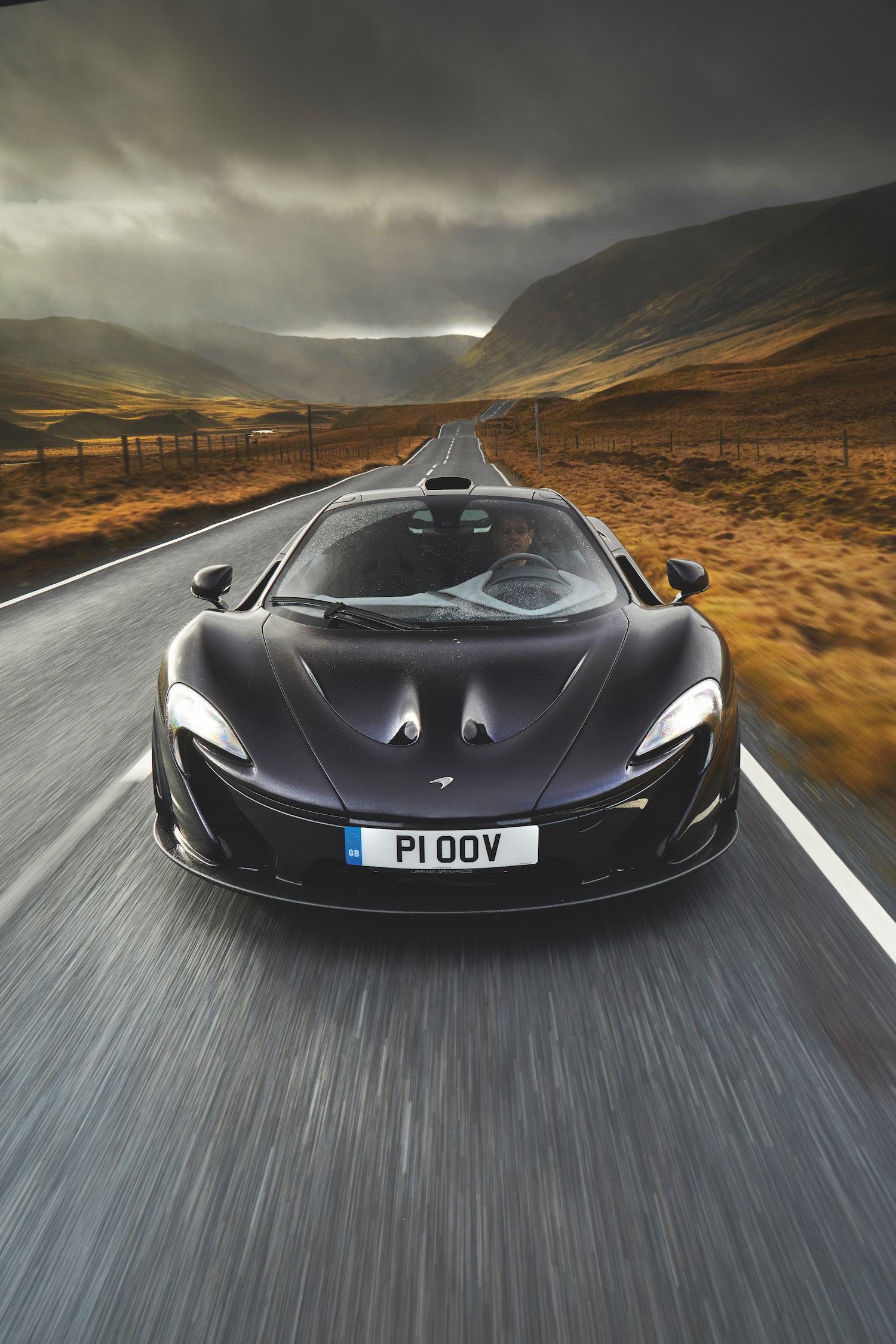
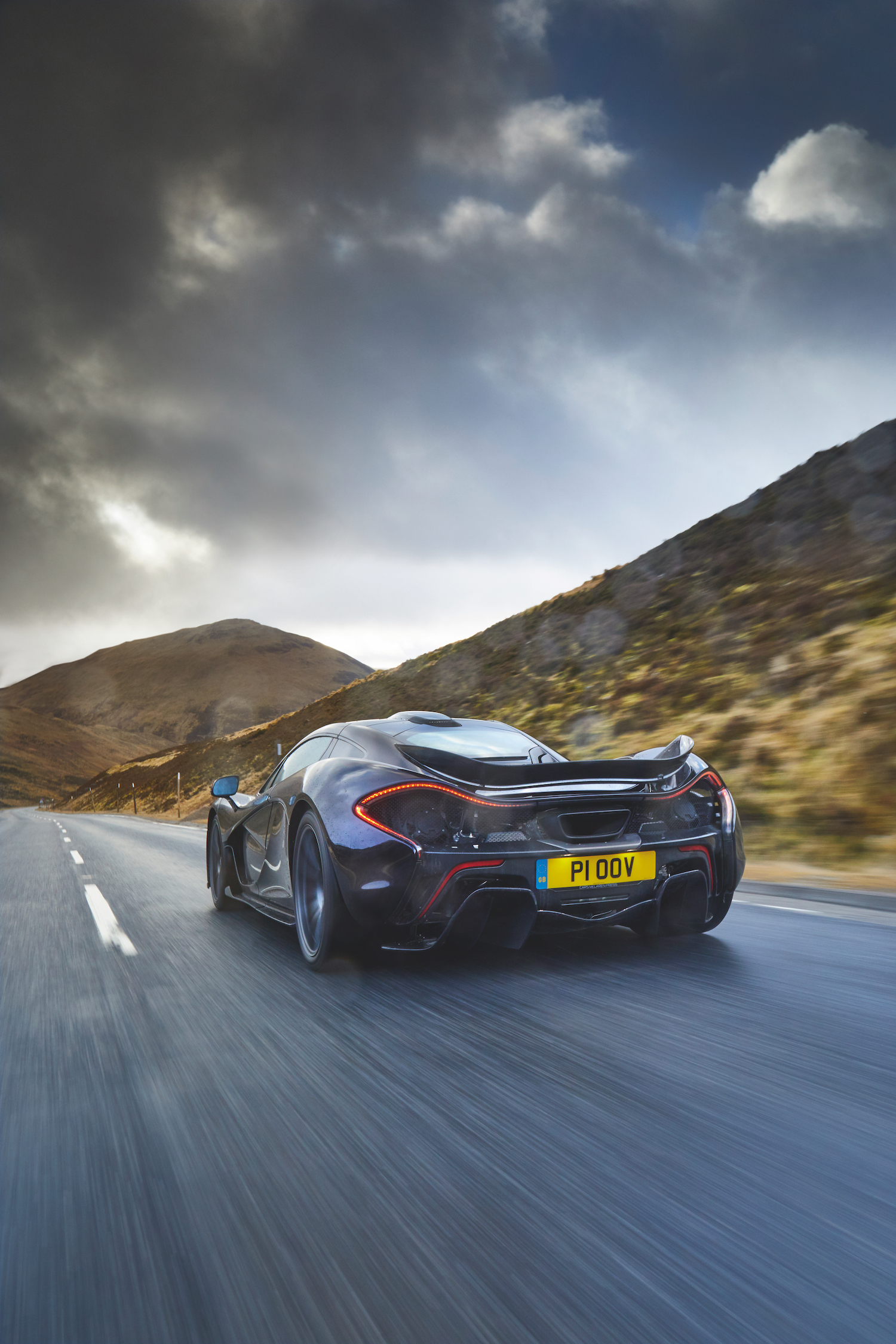
I’m following the Senna in P1 OOV, a pre-production P1 that went on to do press duties and has become an icon in its own right. It’s done over 23,000 miles and feels like an old friend. The Alcantara seats are tight and supportive, the windscreen plunges down to a low scuttle giving a fabulously uninhibited view, and the M838TQ hybrid powertrain is huffing, puffing and whirring away behind. It feels special, it sounds intriguing and the way the car instantly zaps forward with even a tickle of throttle certainly seems to make good on those ‘torque fill’ claims. The shock of 903bhp is timeless.
McLaren’s focus with the P1 is evident everywhere. The ride is pretty tough and noisy, the cabin feels sparse but wonderfully authentic, and the car reacts so quickly and with amazing control to every input. The way the carbonfibre panels are pulled tight like skin over the P1’s bones seems to perfectly describe the driving experience: no waste, no decoration, just action and reaction melded until they become one. You’re shrink-wrapped to this machine as tightly as the organic curves cling to the MonoCage. It could scarcely be more immersive.
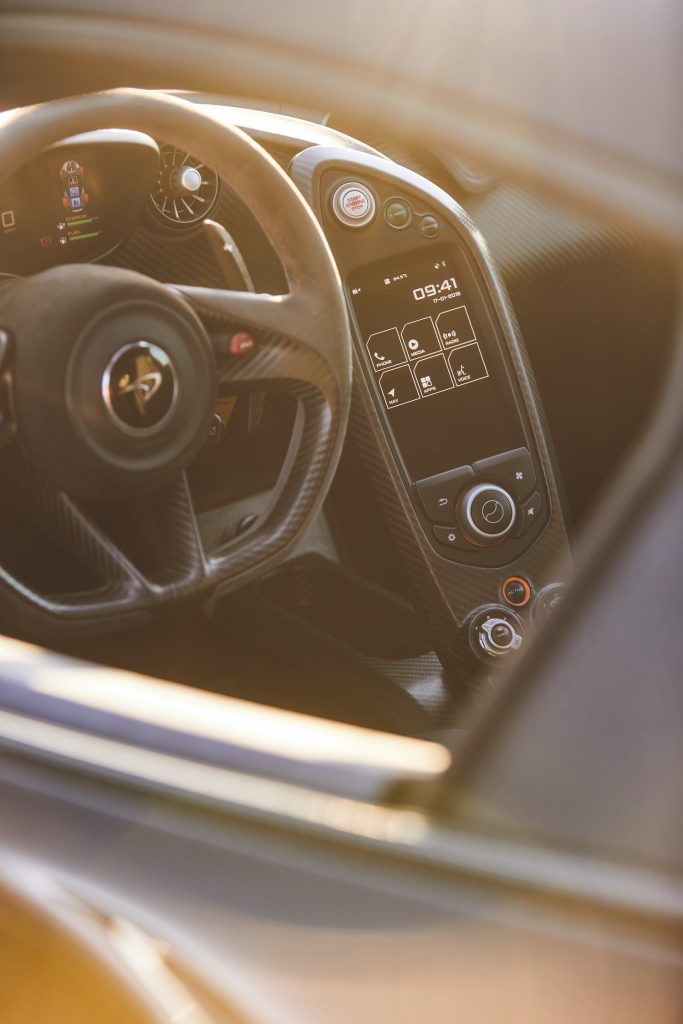
The sun is dazzling, but the temperature is stubbornly hovering around freezing point. Mercifully OOV is rolling on P Zero Corsa tyres rather than the more extreme Trofeo Rs that allow it to pull over 2g in corners on a warm, dry day. Even so, there’s so much more power than traction, and the ESC system is working overtime. In fact, I reckon it’s giving me about 400bhp of the advertised 903bhp most of the time. ESC Dynamic mode is a little less mean, but still keeps a watchful eye, and even part-throttle in fifth or sixth gear creates a momentary squirm followed by an electronically induced stutter to keep the P1 pointing straight.
Better to accept that we won’t be exercising these cars to the limit on the road, and just enjoy the incredible sense of agility, wonderfully feelsome steering and sublime driving position. The P1 feels so light, and despite its extreme nature and power it’s not intimidating. It reacts so accurately that you just seem to will it along this magnificent, soaring road.
McLaren Senna
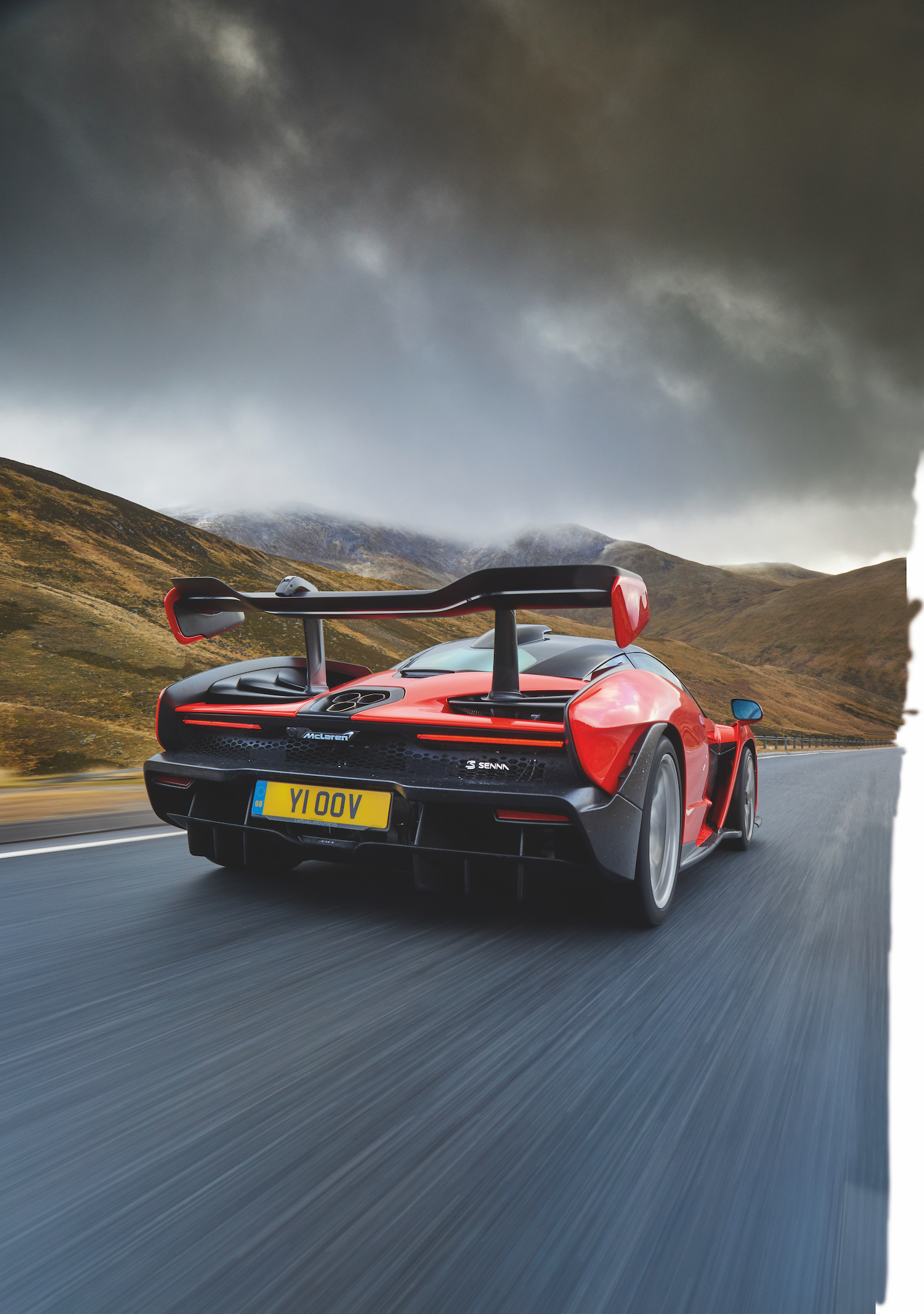
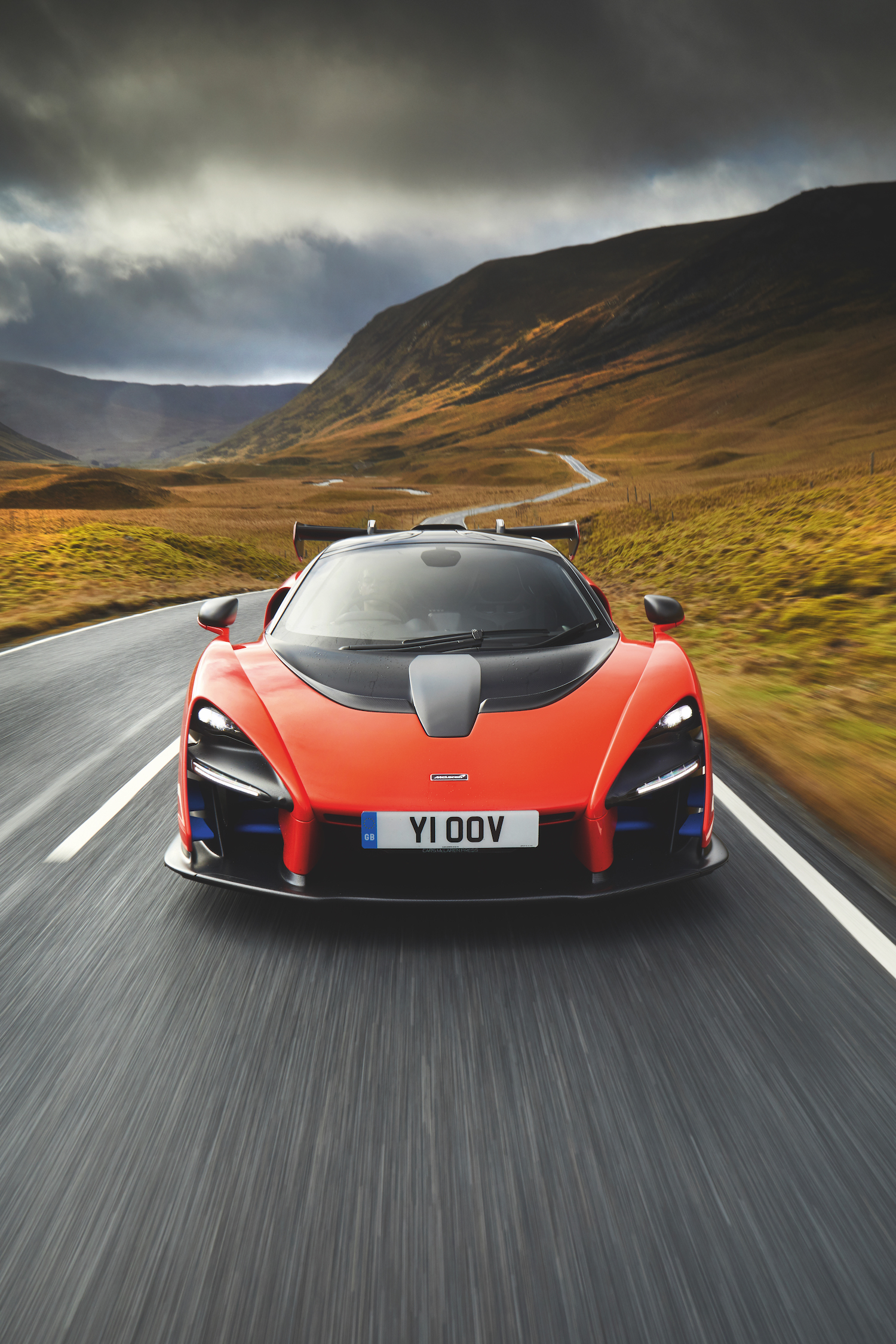
The Senna is different. Yes, you still have to manoeuvre yourself carefully into the driver’s seat and pull firmly down on the dihedral doors. The panoramic screen still creates a sense of liberation. Yet everything else is new. The exposed gas struts, bare floors, strange individual pads that cover the seat shell and Perspex door panels radically alter the vibe. The P1 feels racecar snug; the Senna just feels bare and almost wilfully minimalist.
Reach up to the roof-mounted control cluster and press the red starter button – a little bit of deliberate theatre – but the wry smile doesn’t last long. The 4-litre engine sounds, erm, how can I put this? Ugly. It’s a flat, tuneless noise at idle, and it’s all around you, buzzing into the cabin from all sides. Even the steering wheel fizzes with fast-idle vibrations. There’s an all-pervading sense of impatience. Better get going, then.
Sensations come in frantic bursts. The steering is lighter and unbelievably quick, there’s so much more road noise and the ride feels seized solid even after the P1. It’s quite a shock. And where the P1 has all sorts of intriguing electric noises and soft huffs and chatters from the turbos, the Senna sounds harder, harsher, angrier. God, the brakes are good, though. The pedal bites with absolute immediacy and the feel is the best of any road car I’ve driven. Each carbon-ceramic disc takes three months to make, at huge expense, and you can feel the quality and power. If the P1 is road car dialled up to 11, the Senna’s character is pure racecar. Also dialled up to 11. Maybe 12.
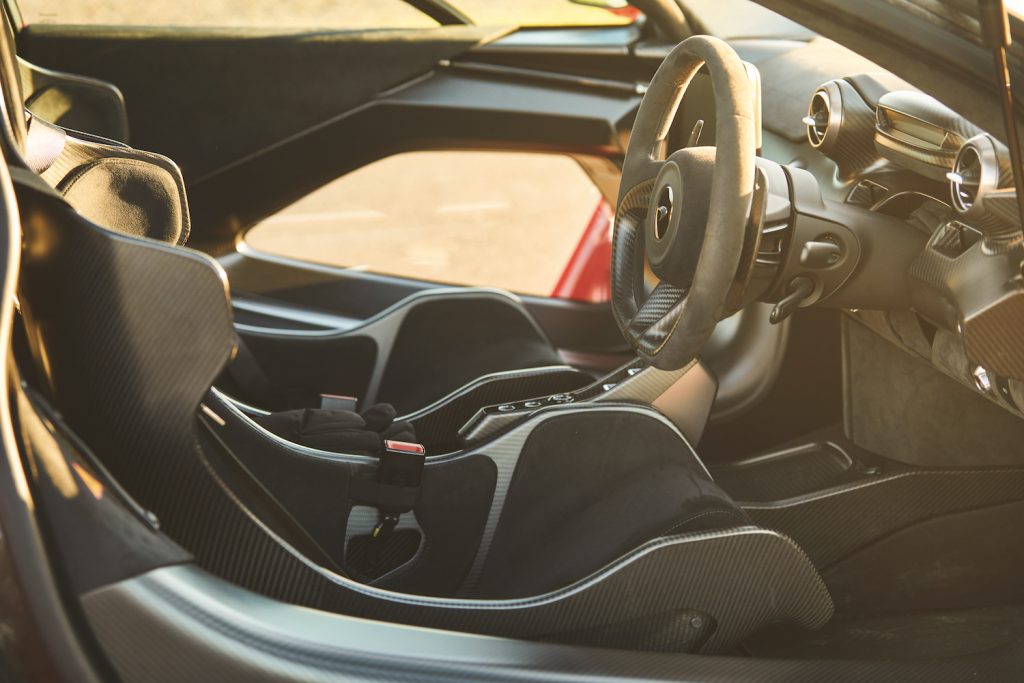
As with the P1, the Senna struggles to put its vast power to the road in these wintry conditions. In fact, the situation is rather exacerbated. The P1’s electric boost at low revs means the tyres lose traction almost immediately. The Senna is more easily caught off boost. That lulls you into a false sense of security as the rear tyres at first cope with quite a bit of throttle. But then the turbos wake up with a huge surge… Cue much swearing and the possibility of a very busy traction-control system even at vaguely unprintable speeds. Holy cow, this thing requires all of your attention.
So it’s more extreme. But once the shock and awe start to subside, you can also feel real progress. The Senna’s damping is so much more sophisticated at speed; it loosens up as your commitment increases, and finds something approaching fluency where the P1 starts to descend into scrappiness on this weather-beaten surface. The aggressive steering rack is perhaps a shade too fast in slippery conditions, as you don’t feel like you’ve got anything to lean against. Think about applying lock and the car is pivoting, and because the body stays so flat the steering doesn’t communicate any load on the treadblocks. The Senna is clearly digging in pretty hard, but it’s so within itself that the driver feels out of the loop.
Push harder and the messages start to flow back, but on unfamiliar and hellishly slippery roads it’s a leap of faith to get there. For some that’ll be off-putting, but it suggests there is a real depth to the Senna’s talents. The more I think about it, the more it seems only right and proper that mastering this extraordinary car requires you to look within yourself and hone skills you never knew you had. I’ll admit to real reservations about christening any car with that name, so I’m relieved to discover it appears to genuinely offer something new and tantalisingly out of reach much of the time.
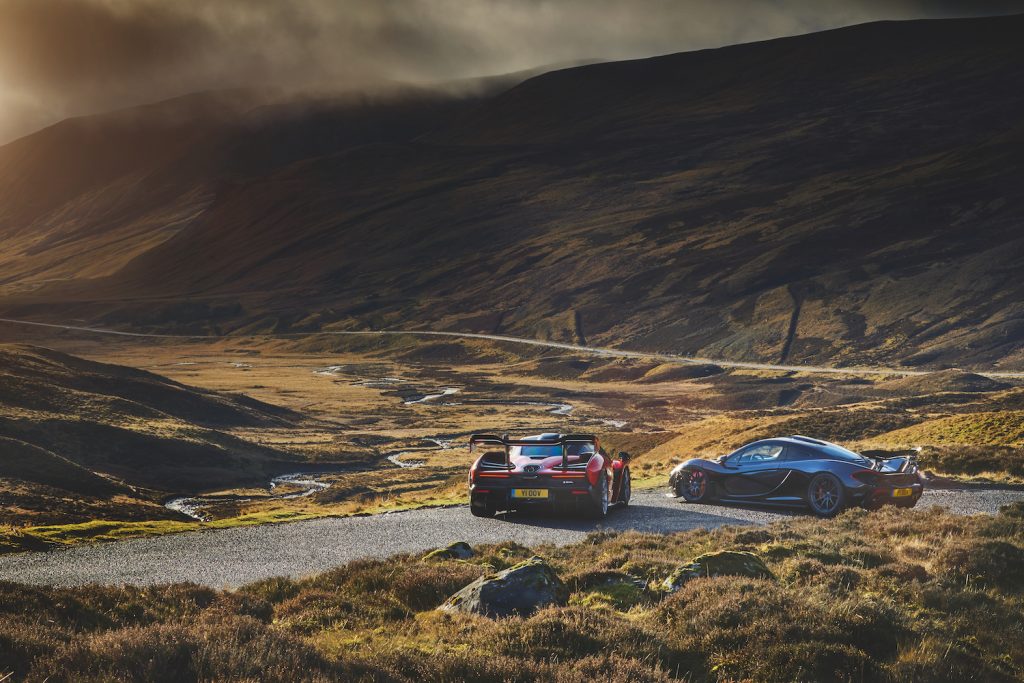
Senna the man had his own heroes, of course – and although the link might be tenuous, our own pilgrimage to Scotland in these cars is partly in deference to another unlikely trip made back in February 1991. Ayrton was reigning world champ and the new F1 season was approaching. However, an invite from a pupil at Loretto School in Musselburgh pulled Senna away from his preparations and towards Scotland. It helped that the kid, Matt Amato, was the stepson of Senna’s great friend Professor Sid Watkins, but the inspiration to accept was more compelling still. Jim Clark went to Loretto School, too.
Senna once called Clark “the best of the best”, and he simply wanted to soak up the places that were important to his boyhood hero. On his short trip to Scotland, Ayrton also headed towards The Borders to pay his respects at the Jim Clark Room in Duns. We’re heading south from Glenshee, too, but won’t make it as far as Clark’s hometown. The blind crests, wicked kerbs and lure of experiencing these cars at something close to their full potential at Knockhill circuit is too great to resist. We think Mr Senna would understand.
To experience the P1 and Senna at their best, you need to select Race mode. On the bumpy roads that rolled through that vast valley we’d been at the other end of the performance envelope – the Handling toggle switch set at Normal and Powertrain dialled up one position to Sport. But Knockhill demands Race. So press and hold the evocatively marked button – on the centre console below those two toggles in the P1, up in the roof panel just behind the start button in the Senna – then release and press again to confirm. Now wait as the suspension drops 50mm in the P1, 39mm in the Senna, as the P1’s rear wing extends and each car transforms. Then simply select first gear with a flick of your right fingers and roll out onto the undulating track…
Here, each car’s character crystallises, and the difference in feel and delivery is remarkable. The P1 is fantastic fun. It howls down the straights, and feels light and nimble. However, such is the power that it’s always just on the cusp of lighting up those rear tyres, and such is the speed it generates that the slightly long, inconsistent brake pedal becomes a point of focus. You sense the P1 is overflowing with energy and the rear tyres, brakes and even the remarkable chassis are stretched to breaking point just to keep up. Its real magic, though, is how progressive it feels at the limit. The hybrid powertrain might overwhelm the mechanical and aero grip at will (especially on such a tight, technical track), but the way it pushes into understeer on turn-in and then makes the transition into oversteer is about as close to ‘creamy’ as you could imagine with 903bhp on tap. It’s a flame-splitting, tyre-killing riot.
The Senna is different. Even on standard P Zero tyres it generates so much more grip and traction that you’d swear it’s wearing slicks. And the brakes; oh my, the brakes. They’re unbelievably powerful, utterly consistent – while the chassis is so stable under extreme loads you feel almost invincible. The 4-litre engine might do without electric assistance, but it’s every bit a match for the P1. You can keep it working harder for longer; where you’re braking in the P1, you’re hitting another upshift in the Senna. It feels absurdly composed – less supercar and more superhero. Does this thing ever give up?
Well, yes, but only when you’re already feeling uncomfortably out of your depth. And unlike the joyously expressive P1, the Senna slips more consistently into understeer, the relatively skinny 245-section front tyres giving up but the immense traction and rear grip making it hard to dance the car as freely as the P1. Usually this would upset me, but such is the Senna’s potential it hardly seems to matter. It’s an experience of such breathless intensity, and one that asks so much commitment from the driver, that whether you can light it up like an old M3 seems irrelevant. The Senna is out of this world.
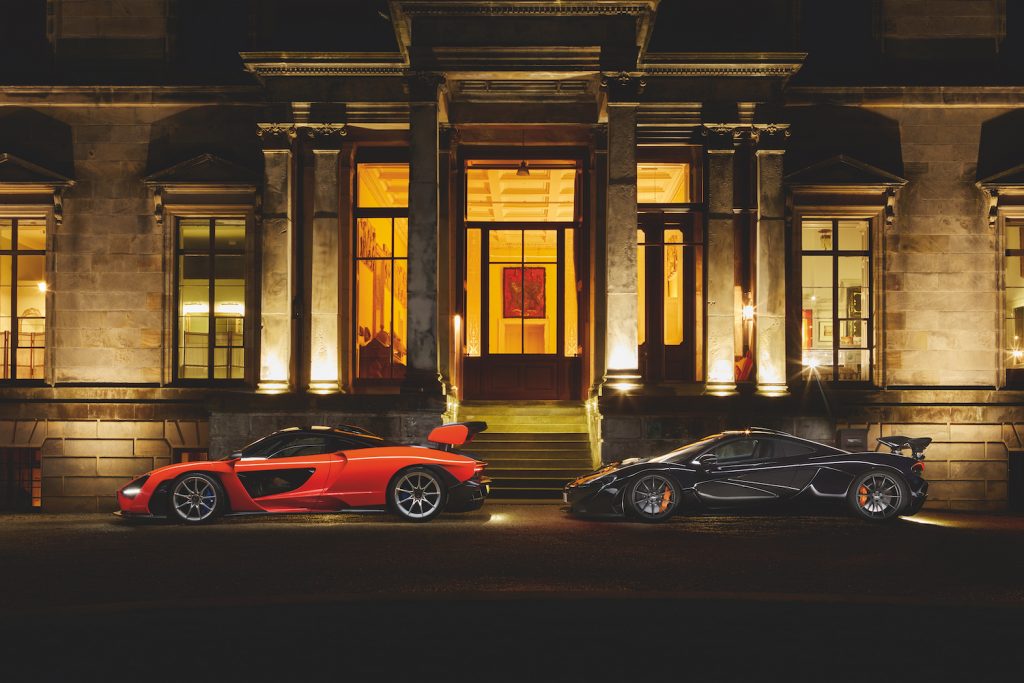
Our final destination is Broomhall House, just ten miles south of Knockhill. Seat of the Bruce family for more than 300 years, it’s another place with an inextricable link to Scottish motorsport. Andrew Bruce, the 11th Earl of Elgin, served as president of Ecurie Ecosse and the Royal Scottish Automobile Club, and remains a huge enthusiast. During our visit, son Charles regales us with stories about his father’s rallying days and various other adventures. This place is dripping with remarkable heritage and artefacts, yet it’s one simple newspaper clipping of Andrew laughing with Senna’s hero, Jim Clark, that brings everything full circle.
But enough. There are two incredible cars outside. If I was planning to head south to the fast, bumpy, narrow lanes that lead to Duns, which would I take? If there was a race track waiting, it’d have to be the Senna. Yet for the journey? The P1. Time moves fast, but quality like this will never fade.
To subscribe to Magneto magazine, follow this link.
Read more
“I want to find out for myself” – I was there the day Ayrton Senna went rallying
Future Classic: McLaren MP4 12C
Driving the Light Car Company Rocket – Gordon Murray’s original hypercar















